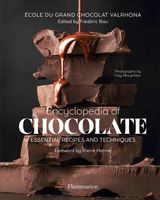Advertisement
From Bean to Bar
Appears in
By Frédéric Bau and École du Grand Chocolat Valrhona
Published 2017
To understand how a bar of chocolate gets to us from the cocoa tree, let’s follow the progress of a handful of beans from a Venezuelan plantation to Valrhona’s production facilities in Tain-l’Hermitage, in the Drôme region of France.
In the hot and humid climate of Venezuela, just as in the entire equatorial zone, cocoa trees flourish and their fruits ripen twice yearly, between November and January, and then again between May and July. The pod is a long fruit, about the size of a melon. Its thick shell protects the precious cocoa beans, which are contained in a gelatinous pulp. This white, sweet-sour pulp, which tastes something like a litchi or custard apple, is eaten raw by the locals. When the husk has been opened to extract the contents, the fresh beans (or seeds) are spread out in large bins or crates for the first stage of their transformation. This is the crucial fermentation phase, when the beans develop the underpinnings to what will be the chocolate aromas. Now a classic chain of chemical reactions ensues: yeast formation transforms the sugar into alcohol (anaerobic alcoholic fermentation); then the farmers rotate the beans for two to eight days, depending on the variety, to accelerate aeration, which helps the development of bacteria (acetic fermentation).

